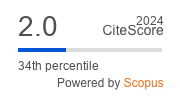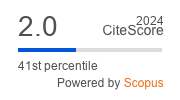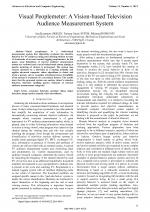| 4/2014 - 11 |
Visual Peoplemeter: A Vision-based Television Audience Measurement SystemSKELIN, A. K. |
| Extra paper information in |
| Click to see author's profile in |
| Download PDF |
Author keywords
consumer behavior, machine vision, object detection, image motion analysis, video surveillance
References keywords
vision(13), recognition(13), tracking(9), pattern(9), attention(9), cvpr(7), machine(6), detection(6), visual(5), television(5)
Blue keywords are present in both the references section and the paper title.
About this article
Date of Publication: 2014-11-30
Volume 14, Issue 4, Year 2014, On page(s): 73 - 80
ISSN: 1582-7445, e-ISSN: 1844-7600
Digital Object Identifier: 10.4316/AECE.2014.04011
Web of Science Accession Number: 000348772500011
SCOPUS ID: 84921682412
Abstract
Visual peoplemeter is a vision-based measurement system that objectively evaluates the attentive behavior for TV audience rating, thus offering solution to some of drawbacks of current manual logging peoplemeters. In this paper, some limitations of current audience measurement system are reviewed and a novel vision-based system aiming at passive metering of viewers is prototyped. The system uses camera mounted on a television as a sensing modality and applies advanced computer vision algorithms to detect and track a person, and to recognize attentional states. Feasibility of the system is evaluated on a secondary dataset. The results show that the proposed system can analyze viewer's attentive behavior, therefore enabling passive estimates of relevant audience measurement categories. |
| References | | | Cited By «-- Click to see who has cited this paper |
| [1] Green, Andrew, "Understanding television audiences," Warc best practice, Issue 9., 2011.
[2] Schmitt, K., Woolf, K., Anderson, D., "Viewing the viewers: Viewing behaviors by children and adults during television programs and commercials," Journal of Communication, 53(2), pp. 265-281, 2003. [CrossRef] [3] Hawkins, R. et al., "What Produces Television Attention and Attention Style?," Human Communication Research 31.1 , pp. 162-187., 2005. [CrossRef] [Web of Science Times Cited 26] [4] Zhou, Z., Chen, X., Chung, Y., He, Z., Han, T., Keller, J., "Activity analysis, summarization and visualization for indoor human activity monitoring," Circuits and Systems for Video Technology, IEEE Transactions on, 18 (11), pp. 1489-1498, 2008. [CrossRef] [Web of Science Times Cited 94] [SCOPUS Times Cited 119] [5] Vinay, V., Mandal, C., Sural, S., "Automatic detection of human fall in video", Pattern Recognition and Machine Intelligence, pp. 616-623, 2007. [CrossRef] [SCOPUS Times Cited 111] [6] Han, Jungong, "Real-time multiple people tracking for automatic group-behavior evaluation in delivery simulation training," Multimedia Tools and Applications, 51.3, pp. 913-933, 2011. [CrossRef] [Web of Science Times Cited 11] [SCOPUS Times Cited 12] [7] Ravnik, R., Solina,F., "Audience measurement of digital signage: Quantitative study in real-world environment using computer vision," Interacting with Computers, 25.3, pp. 218-228, 2013. [CrossRef] [Web of Science Times Cited 23] [SCOPUS Times Cited 35] [8] Ba, S. O., Odobez, J.-M., "Recognizing visual focus of attention from head pose in natural meetings," Systems, Man, and Cybernetics, Part B: Cybernetics, IEEE Transactions on 39.1, pp. 16-33, 2009. [CrossRef] [Web of Science Times Cited 101] [SCOPUS Times Cited 134] [9] Hansen, D. W., Qiang, J., "In the eye of the beholder: A survey of models for eyes and gaze," Pattern Analysis and Machine Intelligence, IEEE Transactions on 32.3, pp. 478-500, 2010. [CrossRef] [Web of Science Times Cited 921] [SCOPUS Times Cited 1213] [10] Langton, S., Watt, R., Bruce, V., "Do the Eyes Have It ? Cues to the Direction of Social Attention," Trends in Cognitive Sciences, vol. 4, no. 2 pp. 50-58, 2000. [CrossRef] [Web of Science Times Cited 656] [SCOPUS Times Cited 737] [11] Stiefelhagen, R.,Yang, J., Waibel, A., "Modeling focus of attention for meeting indexing based on multiple cues," IEEE Transactions on Neural Networks, 13, pp. 928-938, 2002. [CrossRef] [Web of Science Times Cited 98] [SCOPUS Times Cited 133] [12] Asteriadis, S., Karpouzis, K., Kollias, S., "Visual Focus of Attention in Non-calibrated Environments using Gaze Estimation," International Journal of Computer Vision, pp. 1-24, 2013. [CrossRef] [Web of Science Times Cited 36] [SCOPUS Times Cited 42] [13] Voit, M., Stiefelhagen, R., "3D user-perspective, voxel-based estimation of visual focus of attention in dynamic meeting scenarios", International Conference on Multimodal Interfaces and the Workshop on Machine Learning for Multimodal Interaction. ACM, 2010. [CrossRef] [SCOPUS Times Cited 16] [14] Ba, S.O.,Odobez, J.- M. , "Multiperson visual focus of attention from head pose and meeting contextual cues", IEEE Transactions Pattern Analysis Machine Intelligence, 33(1), pp. 101-116, 2011. [CrossRef] [Web of Science Times Cited 94] [SCOPUS Times Cited 113] [15] Gourier, N., Hall, D., Crowley, J., "Estimating face orientation from robust detection of salient facial features," International Workshop on Visual Observation of Deictic Gestures (ICPR), pp. 63-69, 2004. [16] Riener, A., Sippl, A., "Head-Pose-Based Attention Recognition on Large Public Displays," Computer Graphics and Applications, IEEE, 34(1), pp. 32-41, 2014. [CrossRef] [Web of Science Times Cited 9] [SCOPUS Times Cited 9] [17] Viola, P. A., Jones, M. J., "Rapid object detection using a boosted cascade of simple features," Computer Vision and Pattern Recognition (CVPR), IEEE Conference on, vol 1, pp. 511-518, 2001. [CrossRef] [Web of Science Times Cited 9027] [18] Kuzmaniæ Skelin, A., Solina, F., Zanchi, V., "Head pose estimation under weak-perspective projection model," Proc. of Computers in technical systems and Intelligent systems, MIPRO, pp. 173-177, 2008. [19] Babenko, B., Yang, M-H., Belongie, S.,"Robust object tracking with online multiple instance learning," Pattern Analysis and Machine Intelligence, IEEE Transactions on, 33, no. 8, pp.1619-1632, 2011. [CrossRef] [Web of Science Times Cited 1621] [SCOPUS Times Cited 2015] [20] Grabner, H., Leistner, C., Bischof, H., "Semi-supervised on-line boosting for robust tracking," Computer Vision-ECCV, Lecture Notes in Computer Science, pp. 234-247, 2008. [CrossRef] [SCOPUS Times Cited 919] [21] Kalal, Z., Matas, J., Mikolajczyk, K., "Pn learning: Bootstrapping binary classifiers by structural constraints," Computer Vision and Pattern Recognition (CVPR), IEEE Conference on, pp. 49-56, 2010. [CrossRef] [Web of Science Times Cited 948] [SCOPUS Times Cited 1095] [22] Ning, J., Zhang,L., Zhang, D., Wu, C., "Scale And Orientation Adaptive Mean Shift Tracking", IET Computer Vision, Vol. 6, Iss. 1, pp. 52-61., 2012. [CrossRef] [Web of Science Times Cited 91] [SCOPUS Times Cited 127] [23] Baker S, Matthews I., "Lucas-Kanade 20 Years On: A unifying Framework," International Journal of Computer Vision, Vol. 56., Issue 3., pp. 221-255, 2004. [CrossRef] [Web of Science Times Cited 2070] [SCOPUS Times Cited 2584] [24] Maggio, E., Cavallaro, A., "Hybrid particle filter and mean shift tracker with adaptive transition model," Proc. of IEEE Int. Conference on Acoustics, Speech and Signal Processing, pp. 221 - 224, 2005. [CrossRef] [SCOPUS Times Cited 164] [25] Turk, Matthew, and Alex Pentland. "Eigenfaces for recognition," Journal of cognitive neuroscience 3.1., pp.71-86, 1991. [CrossRef] [Web of Science Times Cited 8638] [26] Powers, D., "Evaluation: From precision, recall and F-measure to ROC, informedness, markedness and correlation," Journal of Machine Learning Technologies, 2(1), pp. 37-63, 2011. [27] Morency, L.P.,Sidner, C., Lee, C., Darrell, T., "Head gestures for perceptual interfaces: The role of context in improving recognition," Artificial Intelligence, Vol. 171, pp. 568-585, 2007. [CrossRef] [Web of Science Times Cited 49] [SCOPUS Times Cited 73] [28] Yasmina, A., García-Sevilla,P., Mollineda, R., "Dealing with inaccurate face detection for automatic gender recognition with partially occluded faces," Progress in Pattern Recognition, Image Analysis, Computer Vision, and Applications, pp. 749-757, 2009. [CrossRef] [SCOPUS Times Cited 4] [29] Saxbe, D., Graesch, A., Alvik, M., "Television as a Social or Solo Activity: Understanding Families Everyday Television Viewing Patterns," Communication Research Reports, 28(2), pp. 180-189, 2011. [CrossRef] [Web of Science Times Cited 18] [SCOPUS Times Cited 28] [30] Qing Wang, Feng Chen, Wenli Xu, Ming-Hsuan Yang, "An experimental comparison of online object-tracking algorithms." SPIE Optical Engineering and Applications. International Society for Optics and Photonics, Vol. 8138, pp. 81381A-81381A-11, 2011. [CrossRef] [Web of Science Times Cited 18] [SCOPUS Times Cited 69] [31] Wu, Yi, Jongwoo Lim, and Ming-Hsuan Yang. "Online object tracking: A benchmark." Computer Vision and Pattern Recognition (CVPR), 2013 IEEE Conference on. IEEE, pp. 2411 - 2418, 2013. [CrossRef] [Web of Science Times Cited 3104] [SCOPUS Times Cited 4208] [32] Huang, Gary B., Marwan Mattar, Tamara Berg, and Erik Learned-Miller, "Labeled faces in the wild: A database forstudying face recognition in unconstrained environments." Workshop on Faces in'Real-Life'Images: Detection, Alignment, and Recognition. 2008. [33] Grabner, Helmut, and Horst Bischof. "On-line boosting and vision." Computer Vision and Pattern Recognition, IEEE Computer Society Conference on. Vol. 1, pp. 260-267, 2006. [CrossRef] [SCOPUS Times Cited 1004] [34] Grabner, Helmut, Christian Leistner, and Horst Bischof. "Semi-supervised on-line boosting for robust tracking.", Proc. Of European Conference of Computer Vision-ECCV 2008, pp. 234-247, 2008. [CrossRef] [SCOPUS Times Cited 919] [35] Stalder, S.; Grabner, H.; Van Gool, L., "Beyond semi-supervised tracking: Tracking should be as simple as detection, but not simpler than recognition," IEEE 12th International Conference on Computer Vision Workshops (ICCV Workshops), pp.1409-1416, 2009. [CrossRef] [SCOPUS Times Cited 201] Web of Science® Citations for all references: 27,653 TCR SCOPUS® Citations for all references: 16,084 TCR Web of Science® Average Citations per reference: 768 ACR SCOPUS® Average Citations per reference: 447 ACR TCR = Total Citations for References / ACR = Average Citations per Reference We introduced in 2010 - for the first time in scientific publishing, the term "References Weight", as a quantitative indication of the quality ... Read more Citations for references updated on 2025-06-01 17:36 in 213 seconds. Note1: Web of Science® is a registered trademark of Clarivate Analytics. Note2: SCOPUS® is a registered trademark of Elsevier B.V. Disclaimer: All queries to the respective databases were made by using the DOI record of every reference (where available). Due to technical problems beyond our control, the information is not always accurate. Please use the CrossRef link to visit the respective publisher site. |
Faculty of Electrical Engineering and Computer Science
Stefan cel Mare University of Suceava, Romania
All rights reserved: Advances in Electrical and Computer Engineering is a registered trademark of the Stefan cel Mare University of Suceava. No part of this publication may be reproduced, stored in a retrieval system, photocopied, recorded or archived, without the written permission from the Editor. When authors submit their papers for publication, they agree that the copyright for their article be transferred to the Faculty of Electrical Engineering and Computer Science, Stefan cel Mare University of Suceava, Romania, if and only if the articles are accepted for publication. The copyright covers the exclusive rights to reproduce and distribute the article, including reprints and translations.
Permission for other use: The copyright owner's consent does not extend to copying for general distribution, for promotion, for creating new works, or for resale. Specific written permission must be obtained from the Editor for such copying. Direct linking to files hosted on this website is strictly prohibited.
Disclaimer: Whilst every effort is made by the publishers and editorial board to see that no inaccurate or misleading data, opinions or statements appear in this journal, they wish to make it clear that all information and opinions formulated in the articles, as well as linguistic accuracy, are the sole responsibility of the author.



